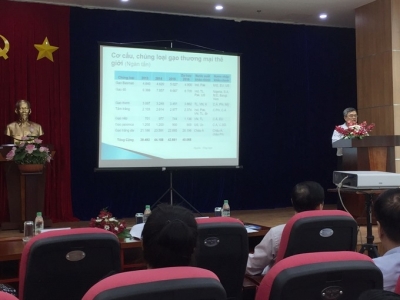Viet Nam rice industry should focus on quality: experts

Huỳnh Minh Huệ, general secretary of the Việt Nam Food Association, speaks at the meeting held in HCM City on October 18 to discuss Việt Nam’s Rice Market Development Strategy from 2017 to 2020. — VNS Photo
Ho Chi Minh City — Vietnamese rice producers and exporters should focus on quality and supplying products that are in demand to sustain the production and export of the grain and add value to the grain, a meeting heard in HCM City yesterday.
Speaking at the meeting held to discuss Việt Nam’s Rice Market Development Strategy from 2017 to 2020, Phan Văn Chinh, head of the Ministry of Industry and Trade’s import-export department, said the global rice market had seen changes, with major importing countries increasing domestic production.
“Free trade agreements theoretically create opportunities for Việt Nam to boost exports to these markets, but to do so Vietnamese rice must meet the quality standards set by these markets.”
To achieve sustainable production and export, the Government has approved a strategy for the 2017–20 period.
Trần Xuân Long of the import-export department said one of the goals of the strategy was to gradually reduce rice export volume but increase value.
Thus, the annual export volume is expected to be 4.5-5 million tonnes by 2020, earning an average of US$2.2-2.3 billion.
Between 2021 and 2030 the annual volume is expected to be around four million tonnes, earning $2.3-2.5 billion. The make-up of the exports would also be restructured then, with a focus on increasing the export of fragrant, speciality, japonica and high-grade white rice, he said.
Việt Nam would focus on Asian and African markets, with China, Bangladesh and ASEAN members such as the Philippines, Malaysia and Indonesia remaining key markets.
Huỳnh Minh Huệ, general secretary of the Việt Nam Food Association, said the main varieties of rice traded in global markets are basmati, parboil, fragrant, white broken rice, sticky rice, japonica, and white long-grain rice.
Việt Nam is well placed in terms of sticky rice, fragrant, white broken rice, and white long-grain rice, he said.
He said rice traders should “capitalise on their advantages to develop nearby and traditional markets whose demands dovetail with Việt Nam’s conditions.”
To improve the competitiveness of rice traders, which is one of the measures in the strategy, businesses should focus on improving quality and marketing and cut costs, he said.
Rice traders and exporters should establish links with farmers to ensure supply meets market demand and efficiency, he said.
Phạm Thái Bình, general director of Trung An Hi-tech Farming JSC, said rice traders who have contracted farmers that use safe production processes have bagged export orders from the beginning.
The country should have zoning plans for each variety of rice based on soil conditions in different areas and use technology to improve the quality and value, he said.
Delegates at the meeting called on the Government to speed up negotiations and sign agreements on hygiene and food safety standards with importing countries.
The Ministry of Agriculture and Rural Development should decide on and apprise exporters about the process of quality inspection and hygiene and food safety regulations in line with those agreements, they said.
Relevant agencies should review seaport planning and speed up loading and unloading of goods at ports to reduce logistics costs, they said.
They called for co-operation among traders in promoting exports.
According to the VFA, Việt Nam is expected to export 5.6 million tones of rice this year
Related news
 Rice exports surpass 2016 volume
Rice exports surpass 2016 volume Vietnam’s rice exports in the year to early this month had risen by a staggering 41% year-on-year to more than 5.2 million tons, beating last year’s volume
 Vietnam targets US$2.5 billion in rice export revenues by 2030
Vietnam targets US$2.5 billion in rice export revenues by 2030 The Ministry of Industry and Trade (MOIT) has set the target of raising Vietnam’s rice export revenues to between US$2.3 and 2.5 billion by 2030.
 Dầu Tiếng Rubber Corporation invests in high-tech agriculture
Dầu Tiếng Rubber Corporation invests in high-tech agriculture Dầu Tiếng Rubber Corporation plans to build a high-tech agriculture zone, on an area of 2,000 hectares to improve efficiency in land use.